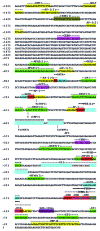Regulation of the human TRAIL gene
- PMID: 22892844
- PMCID: PMC3469471
- DOI: 10.4161/cbt.21354
Regulation of the human TRAIL gene
Abstract
TRAIL is a member of the TNF superfamily that induces tumor-selective cell death by engaging the pro-apoptotic death receptors DR4 and DR5. The antitumor potential of the TRAIL pathway has been targeted by several therapeutic approaches including recombinant TRAIL and TRAIL-receptor agonist antibodies among others. Interest in sensitizing tumor cells to TRAIL-mediated apoptosis has driven investigations of TRAIL-receptor gene regulation, though regulation of the TRAIL gene has been less studied. Physiologically, TRAIL serves as a pro-apoptotic effector molecule in the immune surveillance of cancer that is conditionally expressed by immune cells upon stimulation via an interferon-response element that was identified in early studies of the TRAIL gene promoter. Here, we map the TRAIL gene promoter and review studies of TRAIL gene regulation that involve several modalities of gene regulation including transcription factors, epigenetics, single-nucleotide polymorphisms and functionally distinct isoforms.
Figures





Similar articles
-
Developing TRAIL/TRAIL death receptor-based cancer therapies.Cancer Metastasis Rev. 2018 Dec;37(4):733-748. doi: 10.1007/s10555-018-9728-y. Cancer Metastasis Rev. 2018. PMID: 29541897 Free PMC article. Review.
-
Regulation of TNF-Related Apoptosis-Inducing Ligand Signaling by Glycosylation.Int J Mol Sci. 2018 Mar 2;19(3):715. doi: 10.3390/ijms19030715. Int J Mol Sci. 2018. PMID: 29498673 Free PMC article. Review.
-
Death receptor 5 is activated by fucosylation in colon cancer cells.FEBS J. 2019 Feb;286(3):555-571. doi: 10.1111/febs.14742. Epub 2019 Jan 14. FEBS J. 2019. PMID: 30589515 Free PMC article.
-
DR4-selective tumor necrosis factor-related apoptosis-inducing ligand (TRAIL) variants obtained by structure-based design.J Biol Chem. 2008 Jul 18;283(29):20560-8. doi: 10.1074/jbc.M800457200. Epub 2008 May 12. J Biol Chem. 2008. PMID: 18474604
-
DR4 specific TRAIL variants are more efficacious than wild-type TRAIL in pancreatic cancer.Cancer Biol Ther. 2014;15(12):1658-66. doi: 10.4161/15384047.2014.972183. Cancer Biol Ther. 2014. PMID: 25482930 Free PMC article.
Cited by
-
How do viruses control mitochondria-mediated apoptosis?Virus Res. 2015 Nov 2;209:45-55. doi: 10.1016/j.virusres.2015.02.026. Epub 2015 Mar 1. Virus Res. 2015. PMID: 25736565 Free PMC article. Review.
-
Ethanolic extract of Descurainia sophia seeds sensitizes A549 human lung cancer cells to TRAIL cytotoxicity by upregulating death receptors.BMC Complement Altern Med. 2016 Apr 2;16:115. doi: 10.1186/s12906-016-1094-0. BMC Complement Altern Med. 2016. PMID: 27039295 Free PMC article.
-
The DeISGylase USP18 limits TRAIL-induced apoptosis through the regulation of TRAIL levels: Cellular levels of TRAIL influences responsiveness to TRAIL-induced apoptosis.Cancer Biol Ther. 2013 Dec;14(12):1158-66. doi: 10.4161/cbt.26525. Epub 2013 Sep 19. Cancer Biol Ther. 2013. PMID: 24153058 Free PMC article.
-
Tumor necrosis factor‑related apoptosis‑inducing ligand is a novel transcriptional target of runt‑related transcription factor 1.Int J Oncol. 2022 Jan;60(1):6. doi: 10.3892/ijo.2021.5296. Epub 2021 Dec 27. Int J Oncol. 2022. PMID: 34958111 Free PMC article.
-
Developing TRAIL/TRAIL death receptor-based cancer therapies.Cancer Metastasis Rev. 2018 Dec;37(4):733-748. doi: 10.1007/s10555-018-9728-y. Cancer Metastasis Rev. 2018. PMID: 29541897 Free PMC article. Review.
References
Publication types
MeSH terms
Substances
LinkOut - more resources
Full Text Sources
Other Literature Sources
